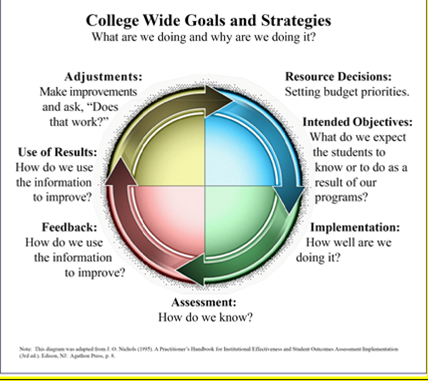6.1 Assessment Guidelines
Assessment is an on-going process that defines goals and objectives, assesses the extent to which the goals and objectives are met, and uses the results to improve operations and communication throughout the organization. The purpose of assessment is to inform the planning process, improve the decision-making process and enhance the educational process through its programs and activities.
This process involves much more than simply “closing the loop” at the end of any given assessment cycle. To foster long-term strategic growth and an environment where improvement is truly continuous, the Deming cycle of continuous improvement is used. The Deming cycle provides a fundamental approach to assessment and acknowledges it not as an end, but as a means to continuous organizational learning and improvement.
The following diagram (based on J. O. Nichols, 1995, A Practitioner’s Handbook for Institutional Effectiveness and Student Outcomes Assessment Implementation, 3rd Edition, Edison, NJ: Agathon Press) depicts the University-wide assessment paradigm and follows the Deming approach:

At the top of the circle, and at the start of the Piedmont University assessment process, are the University-wide goals and strategies. From these University-wide goals, along with their own mission statements that are consistent with the University’s overall mission statement, each academic and non-academic department develops an assessment plan with intended objectives. Next, methods and strategies for achieving those objectives are identified and implemented, as well as methods for assessing the degree to which objectives were met.
Feedback of assessment results are: (a) used at the departmental level to make necessary improvements, (b) reported to the Institutional Effectiveness Committee and (c) used to make improvements to the assessment process itself.
A. Effectiveness Paradigm: Closing the Loop
Each unit within the University develops its own assessment plan, including the development of a mission statement, goals and objectives and methods of assessing the objectives. This assessment plan addresses the relevant University-wide core values and goals and results in the unit’s annual report. The narrative structure of annual reports should include:
- Unit/Department Mission Statement consistent with the University Mission Statement.
- Specific Unit/Department Goals and Strategies.
- Outcomes of the Unit/Department.
- How the outcomes will be assessed.
- How the assessment process closes the loop and is used to make changes or improvements.
- Future objectives and outcomes.
Annual reports and associated assessment activities form the basis of Piedmont’s integrated system by which assessment information informs the planning and budgeting process, both for the University as a whole and for individual departments, units and programs.